Quantitative Simulation and Planning for the Heat Island Mitigation Effect in Sponge City Planning: A Case Study of Chengdu, China
Abstract
:1. Introduction
2. Methods
2.1. Study Area
2.2. Simulation Background Parameter Settings
2.3. Classification and Parameter Setting of Urban Underlying Surface Based on Sponge City Control Zoning
2.4. Parameter Setting of Underlying Surface Composition Properties in the Simulation Scheme
2.5. Simulation Verification
3. Results
3.1. Comparison of Microclimate Elements in Each Case
3.2. Comparison of Air Temperature Field in Each Case
3.3. Comparison of All-Day Heat Island Intensity Between Urban Center Sampling Points and Suburban Sampling Points in Each Case
3.4. Comparison of 24 h Temperature in Different Management and Control Zones in Each Case
4. Discussion
4.1. Impact Mechanism
4.1.1. Vertical Direction: Affecting Urban Energy Distribution Process
4.1.2. Horizontal Direction: Changing Regional Horizontal Advection Patterns
4.2. Sponge City Planning Method Based on the Heat Island Mitigation Target
4.3. Limitations of Simulation
5. Conclusions
Author Contributions
Funding
Data Availability Statement
Conflicts of Interest
References
- Rizwan, A.M.; Dennis YC, L.; Chunho, L. A review on the generation, determination and mitigation of urban heat island. J. Environ. Sci. 2008, 20, 120–128. [Google Scholar] [CrossRef] [PubMed]
- OKET, R. The heat island of the urban boundary layer: Characteristics, causes and effects. Wind Clim. Cities 1995, 277, 81–107. [Google Scholar]
- OKET, R.; Cleugh, H.A. Urban heat storage derived as energy balance residuals. Bound.-Layer Meteorol. 1987, 39, 233–245. [Google Scholar] [CrossRef]
- Taha, H.; Sailor, D.J.; Akbari, H. High-Albedo Materials for Reducing Building Cooling Energy Use; Lawrence Berkeley National Laboratory Report; U.S. Department of Energy: Washington, DC, USA, 1992. [Google Scholar]
- Buchholz, N. Low-Impact Development and Green Infrastructure Implementation: Creating a Replicable GIS Suitability Model for Stormwater Management and the Urban Heat Island Effect in Dallas, Texas. Master’s Thesis, Columbia University, New York, NY, USA, 2013. [Google Scholar] [CrossRef]
- Onmura, S.; Matsumoto, M.; Hokoi, S. Study on evaporative cooling effect of roof lawn gardens. Energy Build. 2001, 33, 653–666. [Google Scholar] [CrossRef]
- Qin, X.; Wu, X.; Chiew, Y.M.; Li, Y. A Green Roof Test Bed for Stormwater Management And Reduction Of Urban Heat Island Effect in Singapore. Int. J. Environ. Clim. Change 2012, 2, 410–420. [Google Scholar] [CrossRef]
- Zhou, Z.; Hao, T.; Tang, W.; Wang, P.; Liu, X.; Xu, Y. The different urban green-land spatial patterns and their environmental effects: A case of the central district of Yichang city, Hubei Province. Acta Ecol. Sin. 2004, 24, 186–192. [Google Scholar]
- Shou, Y.; Zhang, D. Recent advances in understanding urban heat island effects with some future prospects. Acta Meteorol. Sin. 2012, 70, 338–353. [Google Scholar]
- Hand, L.M.; Shepherd, J.M. An Investigation of Warm-Season Spatial Rainfall Variability in Oklahoma City: Possible Linkages to Urbanization and Prevailing Wind. J. Appl. Meteorol. Climatol. 2009, 48, 251–269. [Google Scholar] [CrossRef]
- Streutker, D.R. A remote sensing study of the urban heat island of Houston, Texas. Int. J. Remote Sens. 2002, 23, 2595–2608. [Google Scholar] [CrossRef]
- Xue, Y.; Cai, G.; Guan, Y.N.; Cracknell, A.P.; Tang, J. Iterative self-consistent approach for Earth surface temperature determination. Int. J. Remote Sens. 2005, 26, 185–192. [Google Scholar] [CrossRef]
- Yang, M.; Yang, G.; Wang, Y.; Zhang, Y.; Zhang, Z.; Sun, C. Remote sensing analysis of temporal—Spatial variations of urban heat island effect over Beijing. Remote Sens. Land Resour. 2018, 30, 213–223. [Google Scholar]
- Kustas, W.P.; Norman, J.M.; Anderson, M.C.; French, A.N. Estimating subpixel surface temperatures and energy fluxes from the vegetation index–radiometric temperature relationship. Remote Sens. Environ. 2003, 85, 429–440. [Google Scholar] [CrossRef]
- Trusilova, K.; Jung, M.; Churkina, G.; Karstens, U.; Heimann, M.; Claussen, M. Urbanization Impacts on the Climate in Europe: Numerical Experiments by the PSU–NCAR Mesoscale Model (MM5). J. Appl. Meteorol. Climatol. 2008, 47, 1442–1455. [Google Scholar] [CrossRef]
- Li, X.L.; He, J.H.; Bi, B.G. The desin of urban canopy parameteriaztion of MM5 and its’ numerical simulations. J. Meteorol. 2003, 61, 526–539. [Google Scholar]
- Kusaka, H.; Kimura, F. Thermal effects of urban canyonstructure on the nocturnal heat island:Numerical experimentusing a mesoscale model coupled with an urban canopy model. J. Appl. Meteorol. 2004, 43, 1899–1910. [Google Scholar] [CrossRef]
- Kusaka, H.; Chen, F.; Tewari, M.; Dudhia, J.; Gill, D.O.; Duda, M.G.; Wang, W.; Miya, Y. Numerical Simulation of Urban Heat Island Effect by the WRF Model with 4-km GridIncrement: An Inter-Comparison Study between the Urban Canopy Model and Slab Model (Special Issue on DownscalingStudies for the Impact Assessments of Climate Change). J. Meteorol. Soc. Jpn. 2012, 90, 33–45. [Google Scholar] [CrossRef]
- Chen, F.; Yang, X.; Zhu, W. WRF simulations of urban heat island under hot-weather synoptic conditions: The case study of Hangzhou City, China. Atmos. Res. 2014, 138, 364–377. [Google Scholar] [CrossRef]
- Lin, C.; Chen, F.; Huang, J.C.; Chen, W.C.; Liou, Y.A.; Chen, W.N.; Liu, S.C. Urban heat island effect and its impact on boundary layer development and land–sea circulation over northern Taiwan. Atmos. Environ. 2008, 42, 5635–5649. [Google Scholar] [CrossRef]
- Meng, W.; Zhang, Y.; Li, J.; Lin, W.; Dai, G.; Li, H. Application of WRF/UCM in the simulation of a heat wave event and urban heat island around Guangzhou. J. Trop. Meteorol. 2011, 17, 257–267. [Google Scholar] [CrossRef]
- Cheng, Z.; Sun, C.; Mao, X.; Yang, X. Numerical simulation of the influence of urbanization on summer climate change in Chengdu. J. Chengdu Univ. Inf. Technol. 2016, 31, 386–393. [Google Scholar] [CrossRef]
- Sun, T. On the Sensible and Latent Heat Fluxes from Complex Urban Surfaces. Ph.D. Thesis, Tsinghua University, Beijing, China, 2013. [Google Scholar]
- Sun, Y. Research on the Impace of Urban Expansion on Urban Climate-Taking Wuhan as an Example. Master’s Thesis, Hubei University of Technology, Wuhan, China, 2016. [Google Scholar]
- Huang, C.; Li, D.; Chen, Q.; Wang, X. The effect and mechanism of sponge city construction on heat island mitigation: A case study of Jiaxing. Chin. J. Ecol. 2020, 39, 625–634. [Google Scholar] [CrossRef]
- Liu, Z.; Li, J.; Jiang, D. Evaluation method construction and application of sponge city heat island effect based on URI index. J. Water Resour. Water Eng. 2018, 29, 53–58. [Google Scholar]
- Song, W.; Chen, J.; Liu, X.; Guo, J.; Pu, J. Impact of Sponge city construction on heat island effect of Suining City. Plateau Mt. Meteorol. Res. 2018, 38, 70–76. [Google Scholar]
- Zhu, L.; You, Y.; Cheng, P.; Liu, Y. Study on the effect of sponge construction mode on thealleviation of urban heat island. Water Supply Drain. 2018, 54, 65–69. [Google Scholar] [CrossRef]
- Li, D.; Bou-Zeid, E.; Baeck, M.L.; Jessup, S.; Smith, J.A. Modeling Land Surface Processes and Heavy Rainfall in Urban Environments: Sensitivity to Urban Surface Representations. J. Hydrometeorol. 2013, 14, 1098–1118. [Google Scholar] [CrossRef]
- Hou, A.; Ni, G.; Cong, Z.; Lei, Z. Impacts of coupling urban canopy model on storm simulation. J. Hydroelectr. Eng. 2013, 32, 31–35,42. [Google Scholar]
- Xiao, D.; Chen, J.; Chen, Z.; Zhang, B. Effect Simulation of Chengdu Fine Underlying Surface Information on Urban Meteorology. Meteorol. Mon. 2011, 37, 298–308. [Google Scholar]
- Xue, J.S.; Zong, L.; Yang, Y.J.; Bi, X.Y.; Zhang, Y.H.; Zhao, M.H. Diurnal and interannual variations of canopy urban heat island (CUHI) effects over a mountain–valley city with a semi-arid climate. Urban Clim. 2023, 48, 101425. [Google Scholar] [CrossRef]
- Li, K.; Yu, Z. Relationship between city layout and heat environment based on remote sensing technology: A case study of Wuhan city. City Plan. Rev. 2008, 32, 75–82. [Google Scholar]
- Bateni, S.M.; Entekhabi, D. Relative efficiency of land surface energy balance components. Water Resour. Res. 2012, 48, 11357. [Google Scholar] [CrossRef]
- Yang, Y.J.; Guo, M.; Ren, G.Y.; Liu, S.H.; Zong, L.; Zhang, Y.H.; Zheng, Z.F.; Miao, Y.C.; Zhang, Y. Modulation of Wintertime Canopy Urban Heat Island (CUHI) Intensity in Beijing by Synoptic Weather Pattern in Planetary Boundary Layer. J. Geophys. Res. Atmos. 2022, 127, 35988. [Google Scholar] [CrossRef]
- Chen, S.H.; Yang, Y.J.; Deng, F.; Zhang, Y.H.; Liu, D.Y.; Liu, C.; Gao, Z.Q. A high-resolution monitoring approach of canopy urban heat island using a random forest model and multi-platform observations. Atmos. Meas. Tech. 2022, 15, 735–756. [Google Scholar] [CrossRef]
- Yang, Y.J.; Guo, M.; Wang, L.L.; Zong, L.; Liu, D.Y.; Zhang, W.J.; Wang, M.Y.; Wan, B.C.; Guo, Y.D. Unevenly spatiotemporal distribution of urban excess warming in coastal Shanghai megacity, China: Roles of geophysical environment, ventilation and sea breezes. Build. Environ. 2023, 235, 110180. [Google Scholar] [CrossRef]
- Zheng, Z.F.; Ren, G.Y.; Gao, H.; Yang, Y.J. Urban ventilation planning and its associated benefits based on numerical experiments: A case study in Beijing, China. Build. Environ. 2022, 222, 109383. [Google Scholar] [CrossRef]
- Honnert, R.; Efstathiou, G.A.; Beare, R.J.; Ito, J.; Lock, A.; Neggers, R.; Plant, R.S.; Shin, H.H.; Tomassini, L.; Zhou, B. The Atmospheric Boundary Layer and the “Gray Zone” of Turbulence: A Critical Review. J. Geophys. Res. Atmos. 2020, 125, 30317. [Google Scholar] [CrossRef]
- Wang, C.H.; Wang, Z.H.; Yang, J.C. Cooling Effect of Urban Trees on the Built Environment of Contiguous United States. Earth’s Future 2018, 6, 1066–1081. [Google Scholar] [CrossRef]


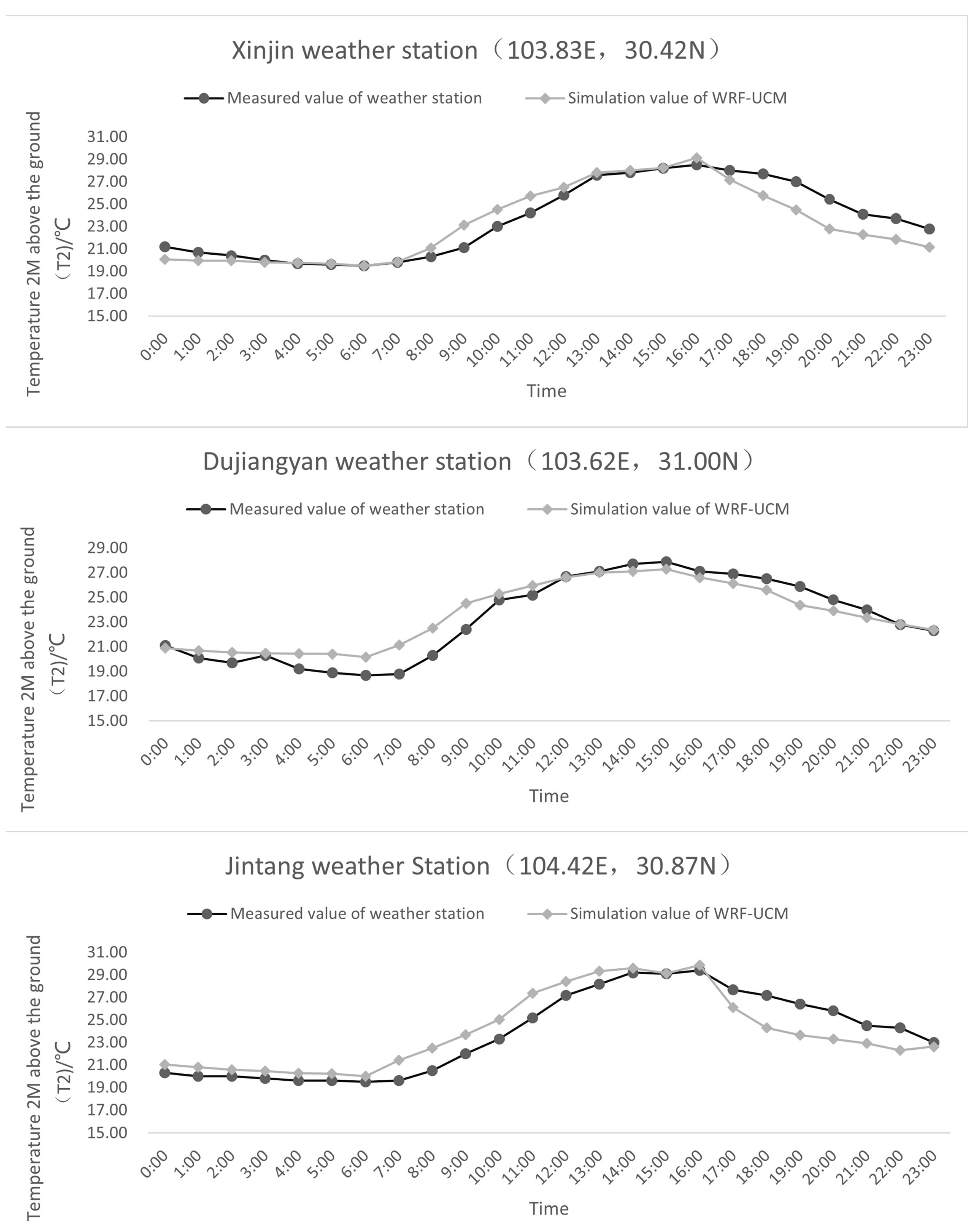

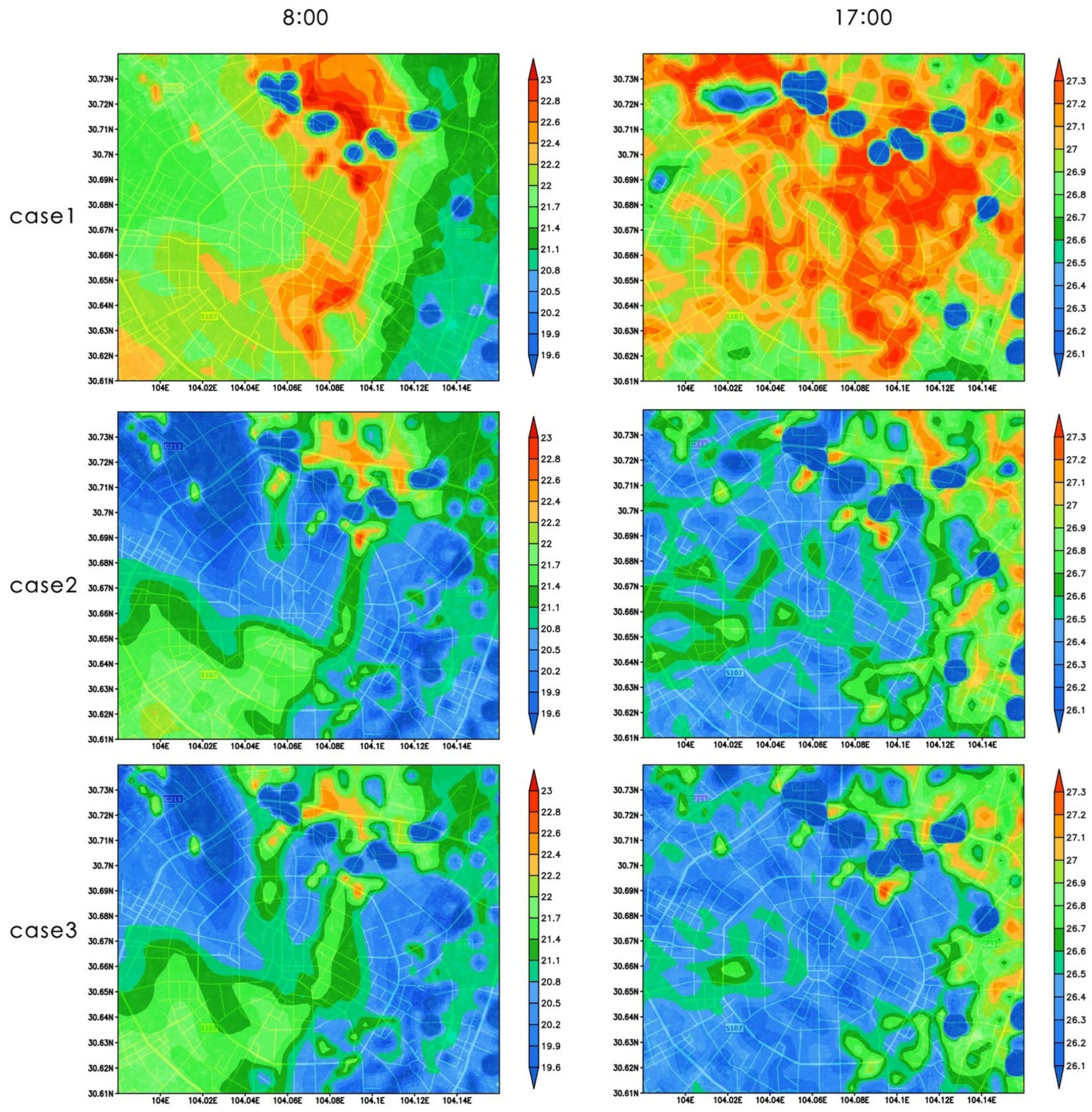

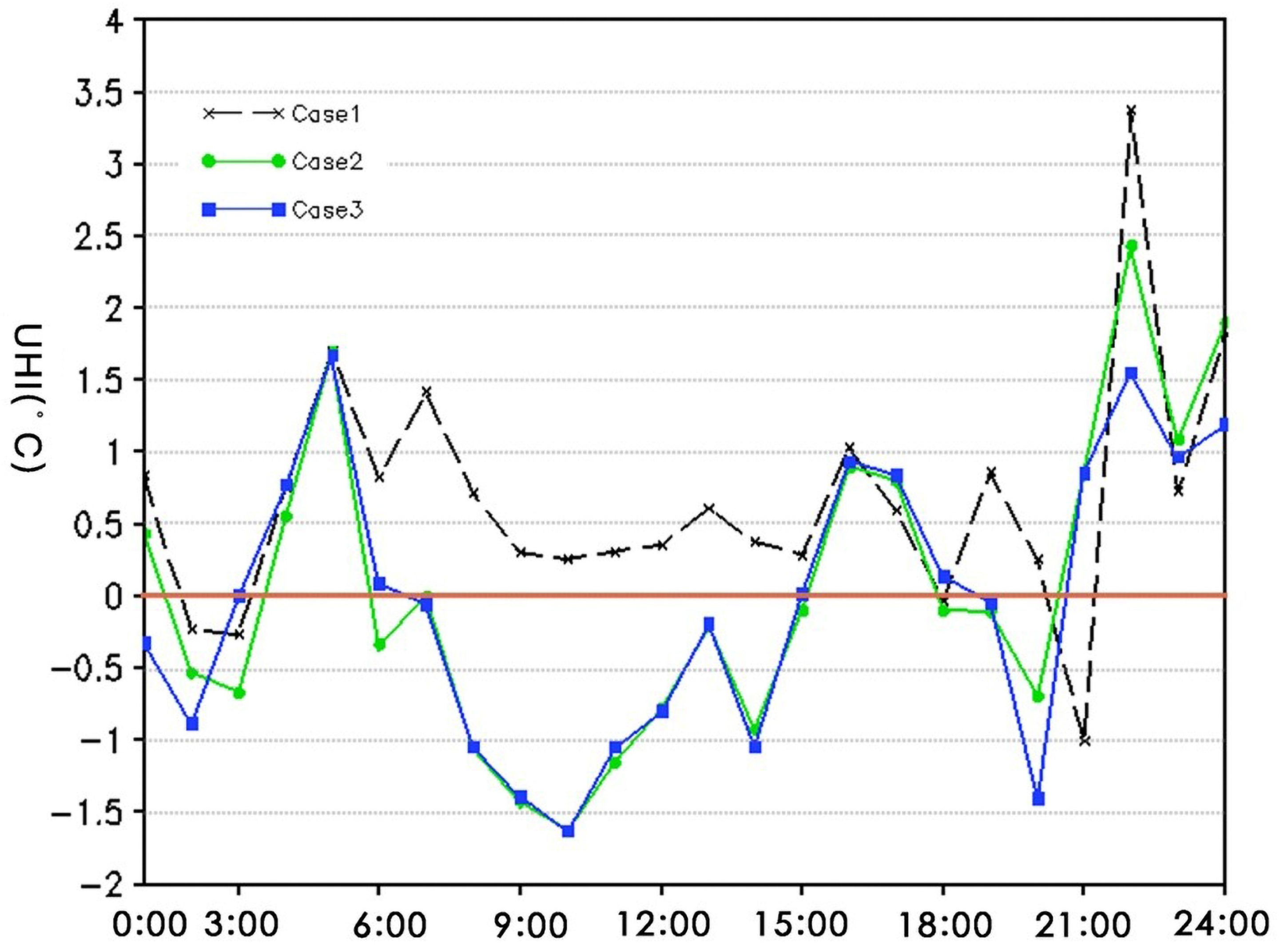
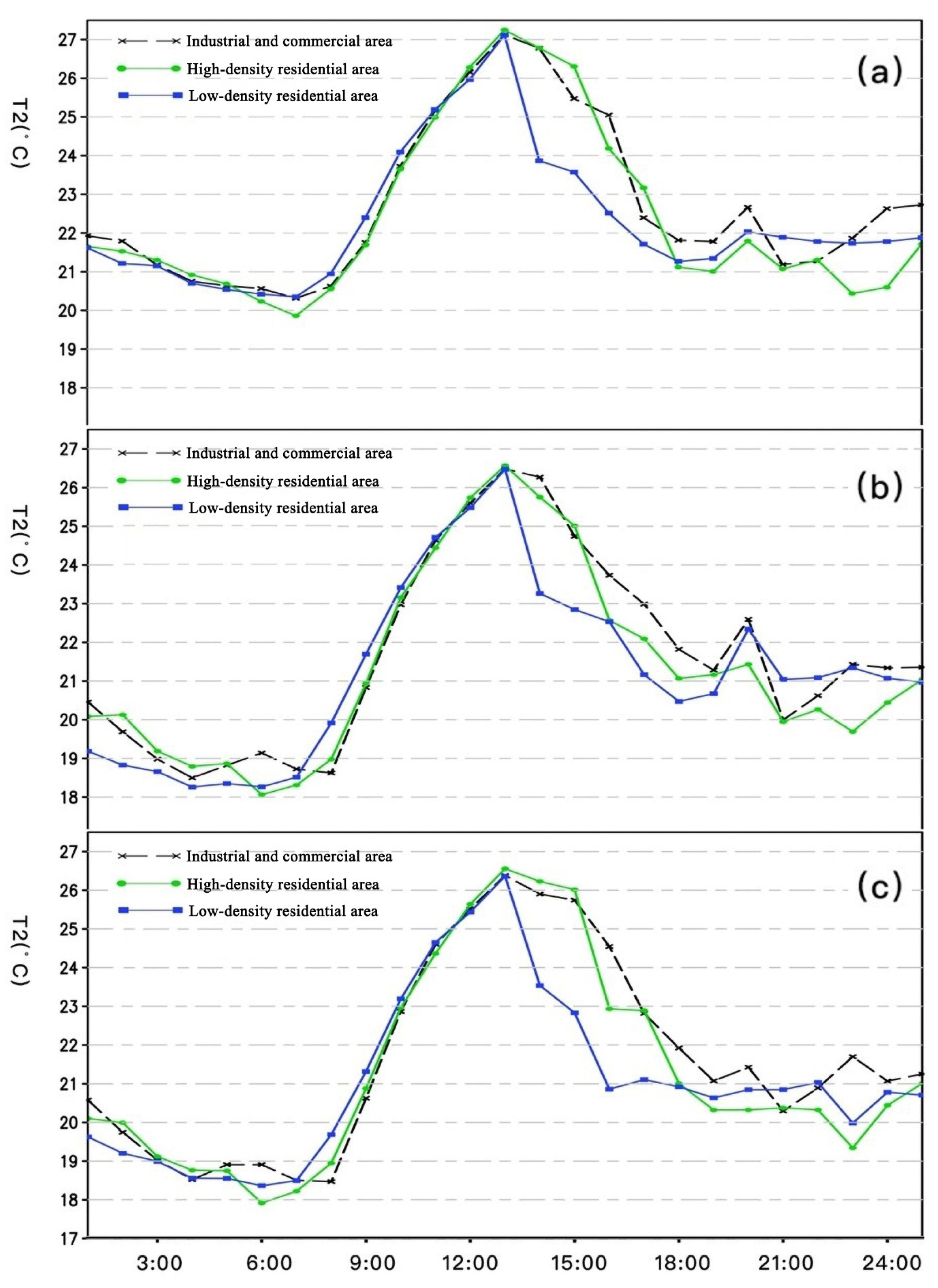
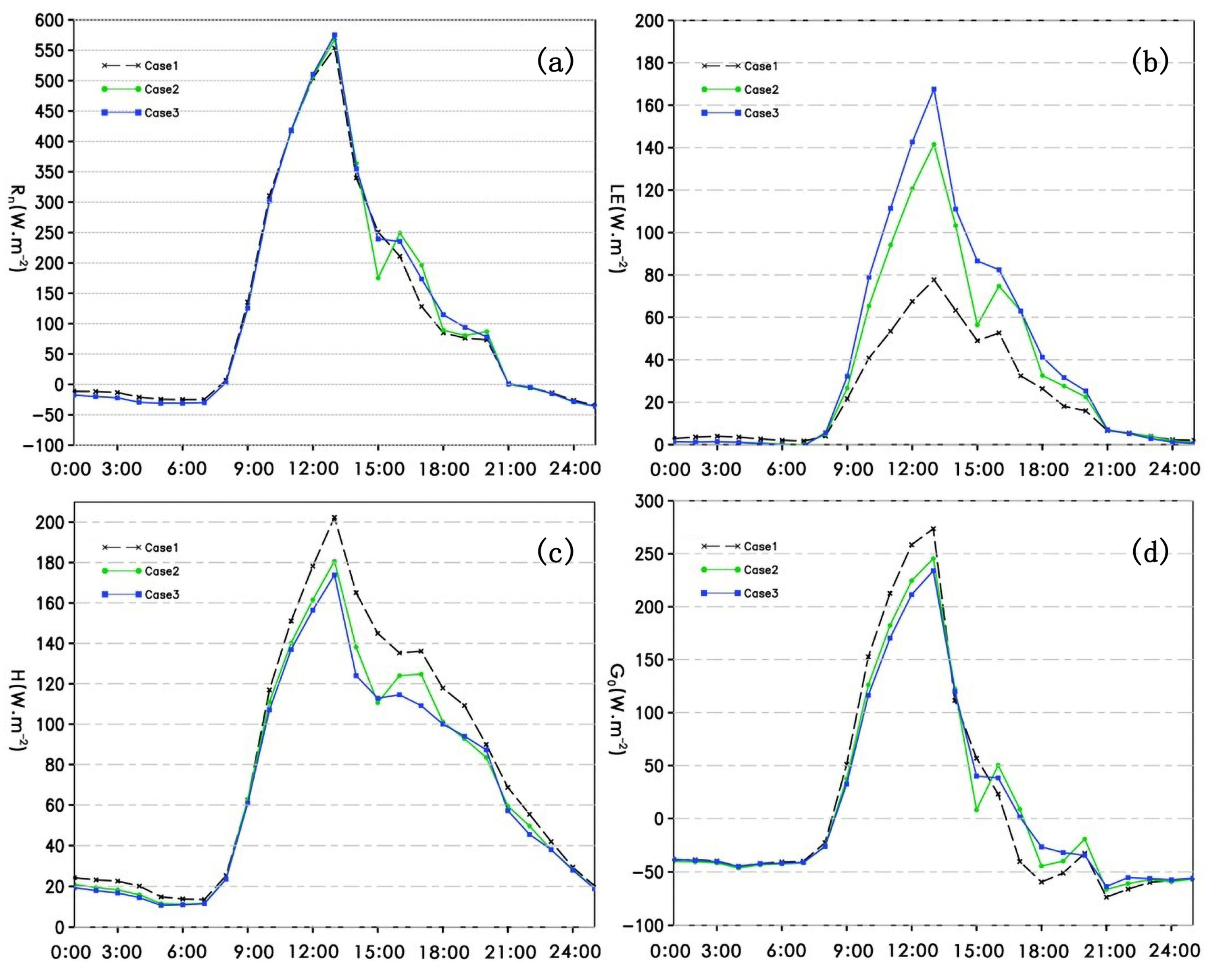


| Domain size (X [km] × Y [km] × Z [km]) | Number of Cells | Grid Cell Size (km) | |
|---|---|---|---|
| Domain 1 | 103.5 × 103.5 × 27 | 69 × 69 × 40 | 1.5 |
| Domain 2 | 24.5 × 24.5 × 27 | 49 × 49 × 40 | 0.5 |
| Physical Process | Parametric Scheme | WRF Scheme Code |
|---|---|---|
| Atmospheric longwave radiation | RRTM | 1 |
| Shortwave radiation | Dudhia | 1 |
| Planetary boundary layer | Esta Similarity | 2 |
| Near-surface layer | MYJ | 2 |
| General land surface process | Noah | 2 |
| Urban land process | UCM | 1 |
| Cloud microphysics | WSM3 | 3 |
| The Imperviousness Rate | UCM Urban Underlying Surface Classification | Sponge City Control Zoning Classification | The Total Annual Runoff Control Rate | The Comprehensive Runoff Coefficient |
|---|---|---|---|---|
| <50% | Low-density residential area | Class III management and control zone | 75% | ≤0.45 |
| 50%~80% | High-density residential area | Class II management and control zone | 70% | ≤0.5 |
| >80% | Industrial and commercial area | Class I management and control zone | 65% | ≤0.5 |
| Parameters | Low-Density Residential Area (Class III Management and Control Zone) | High-Density Residential Area (Class II Management and Control Zone) | Industrial and Commercial Area (Class I Management and Control Zone) |
|---|---|---|---|
| (m) | 32.1 | 22.9 | 27.9 |
| (m) | 25.6 | 10.5 | 23.8 |
| (m) | 17.0 | 9.0 | 10.8 |
| (m) | 14.0 | 19.0 | 15.9 |
| Sky visibility factor (-) | 0.62 | 0.56 | 0.48 |
| Building drag coefficient (-) | 0.1 | 0.1 | 0.1 |
| Anthropogenic heat (Wm−2) | 40 | 60 | 80 |
| City Type | Low-Density Residential Area (Class III Management and Control Zone) | High-Density Residential Area (Class II Management and Control Zone) | Industrial and Commercial Area (Class I Management and Control Zone) | ||||||
|---|---|---|---|---|---|---|---|---|---|
| Simulation Code | Case 1 | Case 2 | Case 3 | Case 1 | Case 2 | Case 3 | Case 1 | Case 2 | Case 3 |
| Green roof rate | 0 | 0.6 | 0.8 | 0 | 0.6 | 0.8 | 0 | 0.6 | 0.8 |
| Greening rate | 0.15 | 0.15 | 0.2 | 0.1 | 0.1 | 0.15 | 0.05 | 0.05 | 0.05 |
| Permeable pavement rate | 0 | 0.6 | 0.5 | 0 | 0.5 | 0.3 | 0 | 0.55 | 0.4 |
| City Type | Case 2 | Case 3 | Comprehensive Runoff Coefficient Control Target |
|---|---|---|---|
| Low-density residential area (Class III management and control zone) | 0.438 | 0.404 | ≤0.45 |
| High-density residential area (Class II management and control zone) | 0.486 | 0.490 | ≤0.50 |
| Industrial and commercial area (Class I management and control zone) | 0.488 | 0.487 | ≤0.50 |
| Meteorological Station | R2 | NSE | PBIAS |
|---|---|---|---|
| Dujiangyan Weather Station (103.62° E, 31.00° N) | 0.922 | 0.883 | −1.264 |
| Jintang Weather Station (104.42° E, 30.87° N) | 0.819 | 0.817 | −0.627 |
| Xinjin Weather Station (103.83° E, 30.42° N) | 0.859 | 0.845 | 1.386 |
Disclaimer/Publisher’s Note: The statements, opinions and data contained in all publications are solely those of the individual author(s) and contributor(s) and not of MDPI and/or the editor(s). MDPI and/or the editor(s) disclaim responsibility for any injury to people or property resulting from any ideas, methods, instructions or products referred to in the content. |
© 2025 by the authors. Licensee MDPI, Basel, Switzerland. This article is an open access article distributed under the terms and conditions of the Creative Commons Attribution (CC BY) license (https://creativecommons.org/licenses/by/4.0/).
Share and Cite
Yang, Q.; Lin, Z.; Li, Q. Quantitative Simulation and Planning for the Heat Island Mitigation Effect in Sponge City Planning: A Case Study of Chengdu, China. Land 2025, 14, 264. https://doi.org/10.3390/land14020264
Yang Q, Lin Z, Li Q. Quantitative Simulation and Planning for the Heat Island Mitigation Effect in Sponge City Planning: A Case Study of Chengdu, China. Land. 2025; 14(2):264. https://doi.org/10.3390/land14020264
Chicago/Turabian StyleYang, Qingjuan, Ziqi Lin, and Qiaozi Li. 2025. "Quantitative Simulation and Planning for the Heat Island Mitigation Effect in Sponge City Planning: A Case Study of Chengdu, China" Land 14, no. 2: 264. https://doi.org/10.3390/land14020264
APA StyleYang, Q., Lin, Z., & Li, Q. (2025). Quantitative Simulation and Planning for the Heat Island Mitigation Effect in Sponge City Planning: A Case Study of Chengdu, China. Land, 14(2), 264. https://doi.org/10.3390/land14020264








